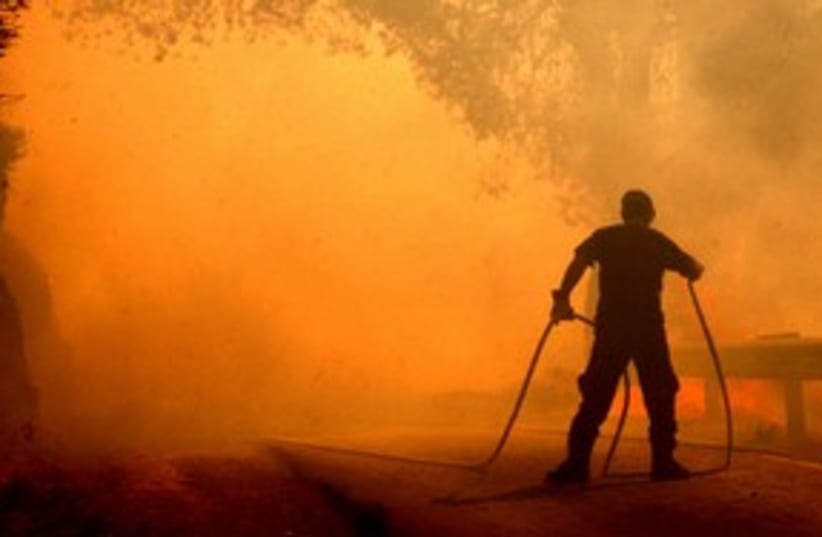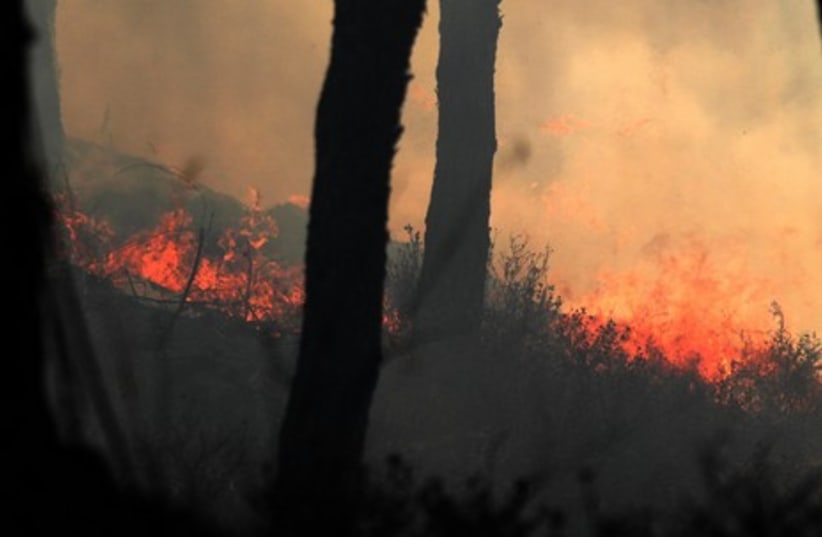
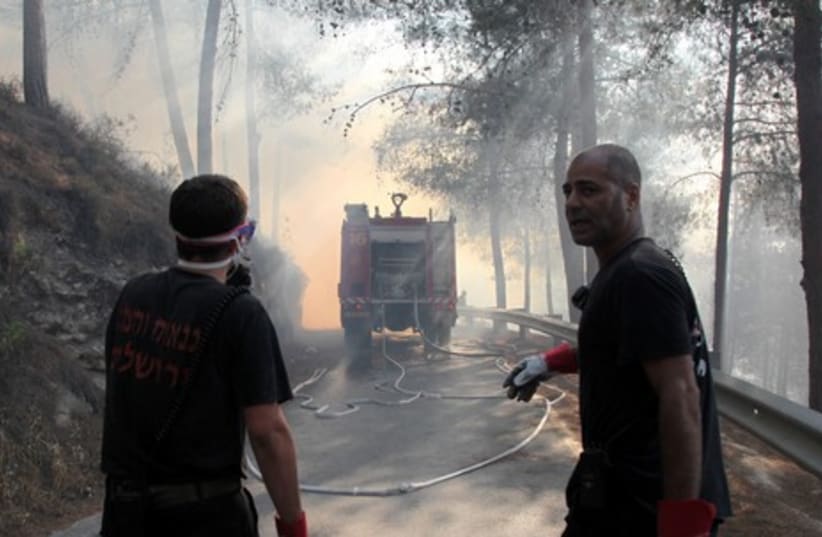
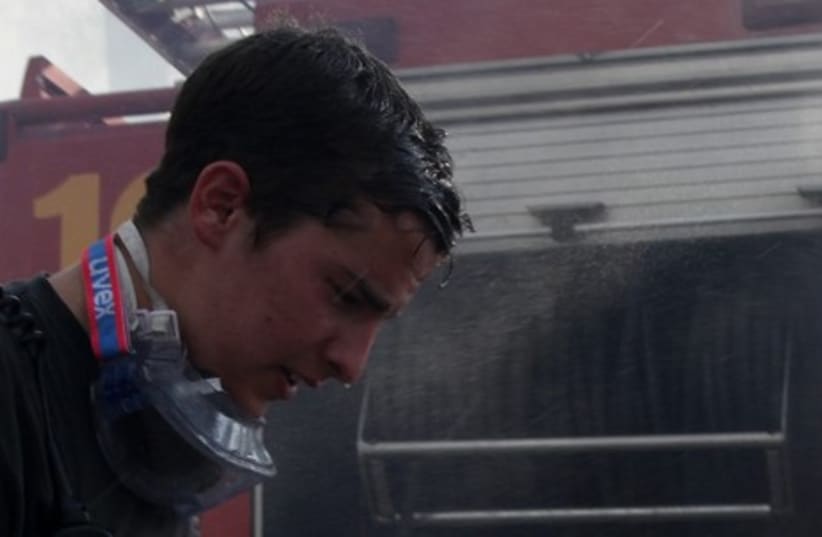

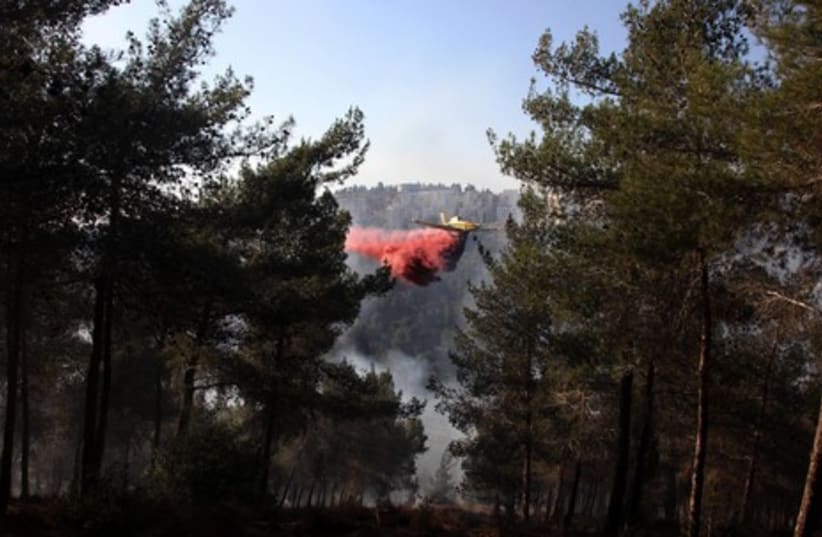
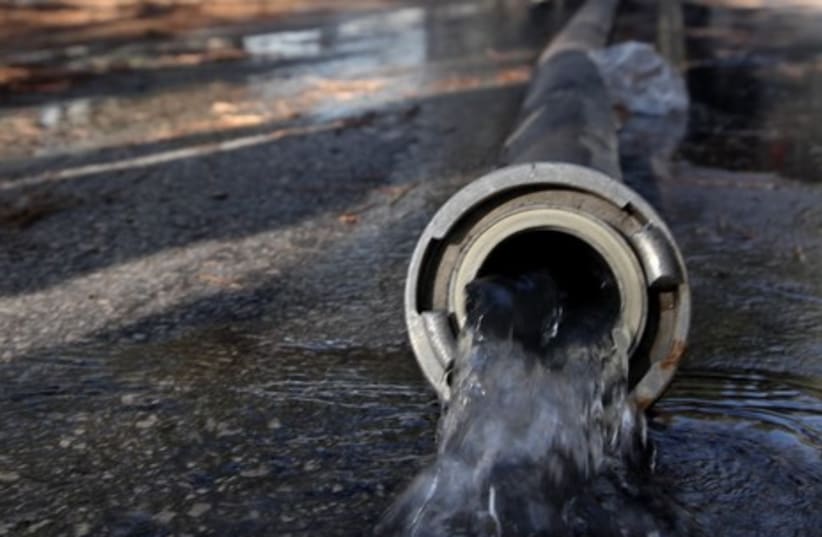
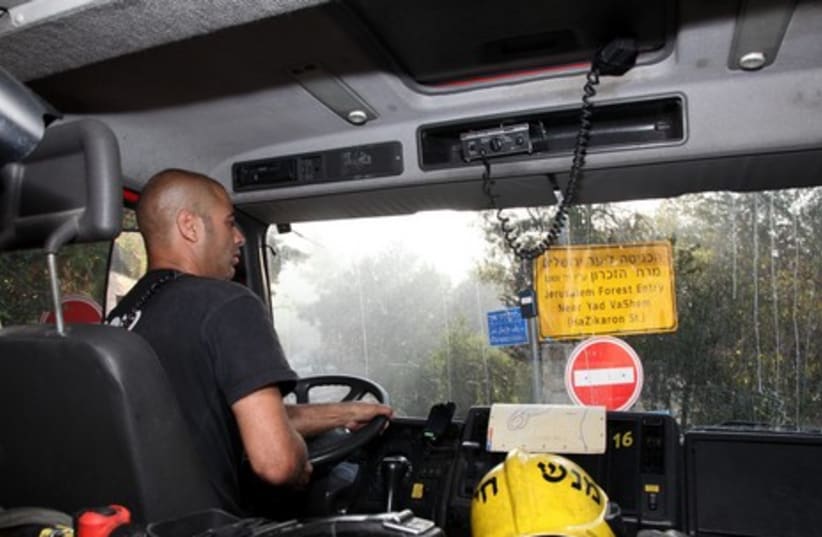
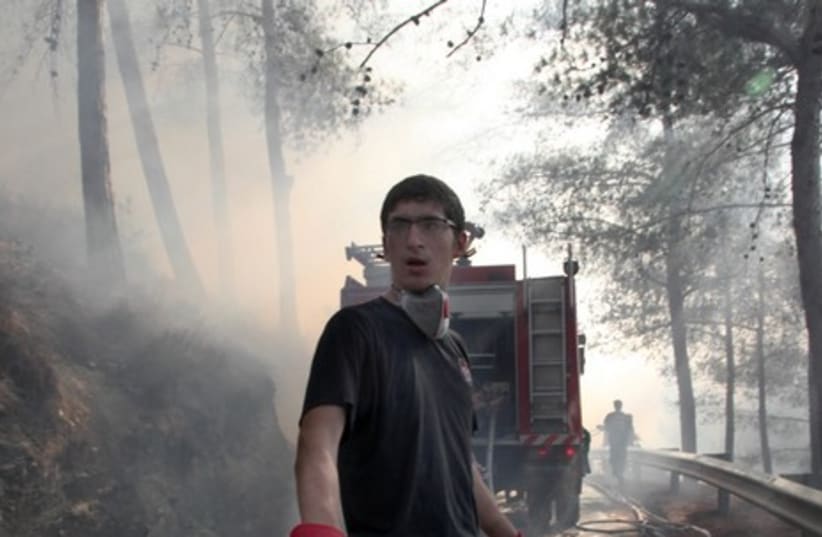
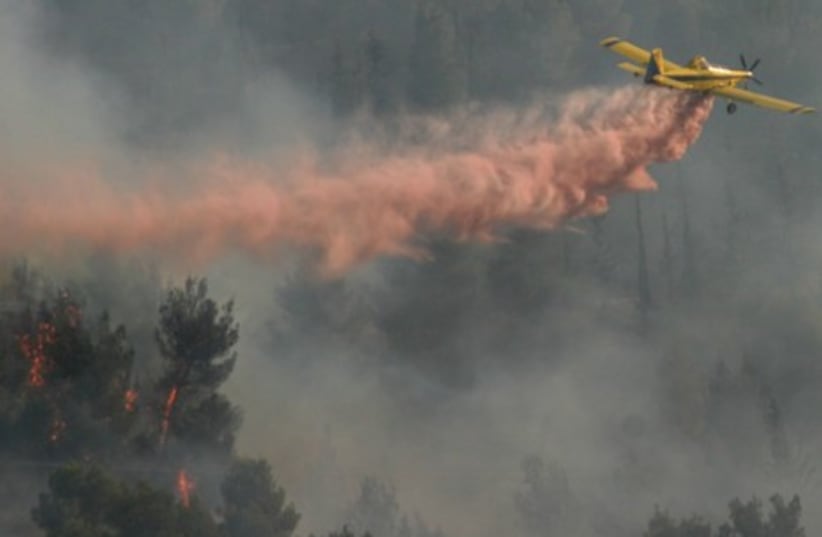
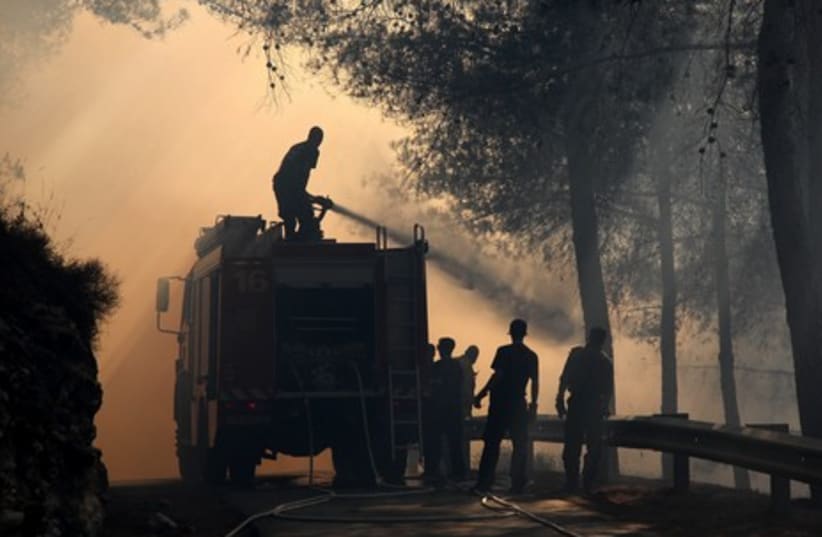
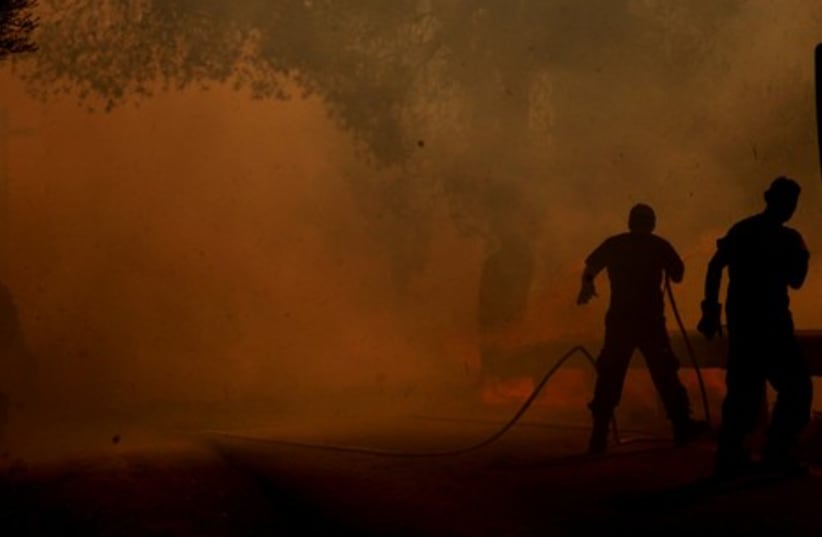

The fire was under control by 8 p.m., Jerusalem Fire and Rescue Services spokesman Asaf Abras said. Approximately 150 dunams (15 hectares) of the Jerusalem Forest were burned. Eight people – five firefighters and three employees at Yad Vashem who assisted in containing the fire around the museum – were treated for smoke inhalation by Magen David Adom. Four were evacuated to hospital.Knesset Speaker Reuven Rivlin and his wife were evacuated from their home in Jerusalem’s Yefeh Nof neighborhood.RELATED:Firefighters control Nahal Gilabon blaze in Golan HeightsNew 3-D firefighting program predicts flame direction“The firefighters are doing their best work,” Rivlin said.“We were burnt in the Carmel Forest, and we must be careful in Jerusalem, as well.”Rivlin’s street was evacuated after nearby streets were filled with smoke, and firefighters feared the flames may reach some of the homes in the area.People in the Beit Hakerem and Har Nof neighborhoods were asked to stay inside with the windows closed, or to avoid the area altogether, and the smoke reached as far as the Katamon neighborhood.Police closed all of the roads around Mount Herzl and Yefeh Nof because of the smoke, starting at 4:30 p.m. The roads remained closed for the duration of the night due to the hazardous flame-retardant materials dumped by the firefighting planes. Authorities will wash the streets on Monday before allowing traffic to resume.Jerusalem Police chief Cmdr. Nisso Shaham said the fire would be allowed to burn out in the ravine and the fire and police would concentrate their efforts on protecting the nearby neighborhoods. Twentythree fire fighting crews from Beit Shemesh, Ramle and from an officer’s training course in Rishon Lezion, and 60 firefighters from the Jewish National Fund were involved in containing the blaze. Four firefighting planes dumped red flame-retardant until dusk.A JNF spokeswoman said the favorable weather kept the flames from getting out of control.“The Jerusalem Forest is well maintained and not very crowded, and there isn’t a lot of dry material,” said the spokeswoman. The fire was mostly on the ground, rather than on the treetops, as was the case in December’s deadly Mount Carmel fire.Sunday’s blaze was approximately the same size as the one last summer near Hadassah University Medical Center in Ein Kerem, and Moshav Bar Giora.The flames broke out simultaneously in four spots in the Jerusalem Forest, at approximately 3:30 p.m. Abras said firefighters would investigate the cause of the fire over the coming days, but the simultaneous outbreaks “raised a lot of questions.”One fire reached the western edge of the Yad Vashem campus, which is far from the museum building but close to the educational center. The museum used its own fire extinguishing equipment and the fire never entered the campus.“We’ve improved our procedures, and after the Carmel fire we purchased a lot of equipment,” said Avner Shalev, the chairman of the Yad Vashem Directorate, as he stood outside the museum, where fire, police, emergency services and the army had set up a command center. Hundreds of visitors were evacuated around 4 p.m., an hour before normal closing time on Sundays.“We stopped the fire, it’s a fact,” Shalev said.He said that after Sunday’s fire, the museum would add an additional pipeline of water defense. Yad Vashem employees had been ready to start emergency evacuation of the most important artifacts from the museum, but they quickly realized it would not be necessary, Shalev said.The most dramatic moments of the day came from the Haim Tzippori Guest House, better known as the Tzippori Center, an ecological learning center in the middle of the forest that runs a day camp and had more than 700 people on the campus in the afternoon.Buses were sent to evacuate the children in order to reassure worried parents, but there was never any immediate need to evacuate the people at the center, Shaham said.A few private cars were burned near the center but there were no injuries, Abras said.Micha’el Oren, who was leading a weeklong retreat in the Tzippori Center for 20 people recovering from cancer, said there was a lot of anxiety, but no one felt unsafe.“When the electricity went out, around 4, that’s when people started getting worried, because we knew it was serious,” he said on Sunday evening. “They kept saying the road is open, now the road is closed, now it’s open, we didn’t know. Families started getting worried and they were calling to see if everyone is okay,” Oren said.The retreat participants kept to their planned schedule even as the flames spread toward their location, and holding workshops and eating dinner at the center’s hostel. After dinner, around 6:30, buses took them to another hostel because the electricity at the center was still out. But Oren said the evacuation was carried out in an “orderly and calm” fashion. The Tzippori Center will remain closed on Monday.The Fire and Rescue Services had flagged the forest outside Yad Vashem as a major “area of concern” for fires.They were planning a large drill for next week, coordinated with police and emergency services, simulating a large fire approaching Yad Vashem.“We’re all kind of laughing to ourselves, because there’s no drill, we got it in real time,” Abras said.He added that since the Carmel fire in December, when 44 people died and dozens were injured, the coordination between firefighters, police and the army had improved. The most important lesson learned from the Mount Carmel fire was to send in five or six crews as soon as possible, rather than waiting for the first crew to report back, something that was instrumental in containing the fire on Sunday.Interior Minister Eli Yishai credited his own work after the Carmel fire for “strengthening the forces in the field and the firefighters,” he said in a statement on Sunday night. “In [today’s] event, we saw the power of aerial extinguishing. If the Sharon government hadn’t canceled the aerial firefighting, the Carmel disaster too would have had a different outcome,” Yishai said.The Jerusalem Forest fire follows a weekend of flames that burned approximately 10,000 dunams of land in Ein Tina, a nature reserve straddling the Upper Galilee and the Golan Heights, according to Fire and Rescue Service spokesman Yoram Levy.
Eye witnesses participating in an Amazing Israel Taglit-Birthright Israel trip said they found the circumstances of the fire particularly eerie, as they had just left Yad Vashem, where exhibits had covered the Nazis’ crematoria.“It was odd, for lack of a better word, to see ash raining down just after having seen the Holocaust museum,” Michael Donkin, a 26-year-old trip member from Washington, DC, told The Jerusalem Post early on Sunday evening, after being evacuated from the area. “Since the Israeli soldiers we were with did not seem concerned, none of us Americans felt ill at ease.”Sharon Udasin and Jonah Mandel contributed to this report.